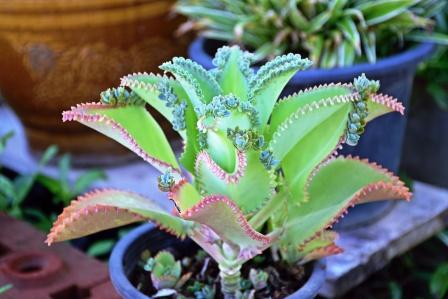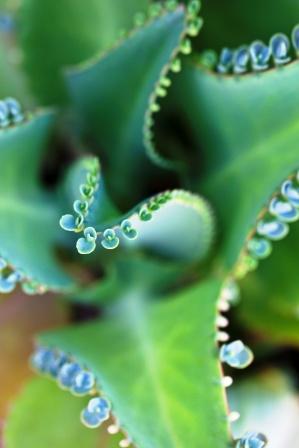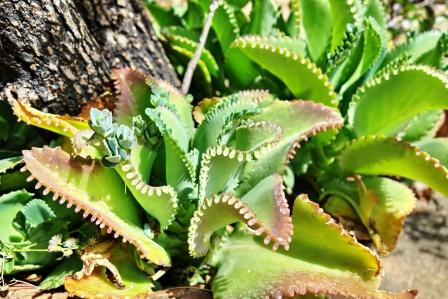Parnabeeja Bryophyllum pinnatum Uses, Research, Side Effects
Parnabeeja- Bryophyllum pinnatum (Lam.) Kurz. is a herb used for the treatment of wounds, ulcers, piles and to control bleeding.
Botanical Name- Bryophyllum pinnatum (Lam.) Kurz., Bryophyllum calycinum
Family- Crassulaceae (Parnabija kula)
Bryophyllum calycinum Salisb. has been used synonymously for the plant Parnabeeja

Table of Contents
Systemic classification
Kingdom: Plantae
Division: Magnoliophyta
Class: Magnoliopsida
Order: Saxifragales
Genus: Kalanchoe
Section: Bryophyllum
Species: K. pinnata
Vernacular names
Names in different languages:
English name – air plant, cathedral bells, life plant, miracle leaf, and Goethe plant, Bryophyllum
Hindi Name- Airavati, Pathacharuti
Unani Name-Jhakme hayat
Telugu Name- Ranapalaku
Bengali Name- Koppata
Gujarati Name- Ghaimari
Marathi name- Panfuti
Oriya name- Amarapoi
Telugu name- Ranapalaku
Urdu name- Jhakme hayat

Habitat, morphology
Parnabeeja is a small shrub growing up to a height of 1-4 feet and found abundantly in the warm and moist parts of central and eastern India. This plant is a native of Madagascar country.
This plant is not mentioned in any Samhitas of Ayurveda like Charaka, Sushruta, Astanga Sangraha/ Hridaya or in any popular Nighantus like Dhanwantari Nighantu, Bhava Prakasha.
Morphology of Bryophyllum calycinum:
Parnabeeja is a small plant growing to a height of 1-4 feet. The leaves are thick, fleshy, round to oval in shape. The flowers are 1-1.5 inch long, greenish purple in color. The seeds are small, round, slimy with small ridges. New growth is seen from the edges of the leaf. Flowers are seen in the month of October- November. The plant can be found all over India in the temperate climate.

Properties, part used, dosage
Bryophyllum pinnatum medicinal qualities:
Guna (qualities) – Laghu – light to digest, Rooksha – Dryness
Rasa (taste) – Kashaya – Astringent, Amla – sour
Vipaka (taste conversion after digestion) – Madhura – sweet
Veerya – Sheeta – Coolant
Effect on Tridosha: Kapha-Pitta Hara (Reduces the vitiated Kapha and Pitta dosha), Raktastambhana ( helps in coagulation of blood), Vranaropana (helps in the wound healing)
Pharmacological action – Diuretic
Useful part: Leaf
Dosage- Fresh juice is administered in the dose of 10-20 ml, before or after food.
Paste of leaf- Used externally
Synonyms
patrabija – New plant originates from leaves
Raktakusuma – Flowers of parnabija are reddish purple in colour
Chatushkonaka – Stems are obtusely four angled.
Chemical composition
The leaves of the plant Bryophyllum pinnatum yield glycosides of quercetin and kaempferol and fumaric acid. The extracts of the plant are anti- fungal in nature.

Uses, precautions
Uses of Parnabeeja – Bryophyllum pinnatum
- The paste of the leaves of Bryophyllum pinnatum is used for external application in the treatment of boils, insect bites and burns.
- The decoction of the leaves of the plant Bryophyllum pinnatum along with Aegle marmelos (Bilwa) is given to treat dysentery in a dosage of 30-40 ml in divided dose.
- The fresh juice of the leaves of Parnabeeja is given in a dose of 8-10 ml to control bleeding piles, fresh wounds and dysmenorrhea.
- Juice of the leaf is given in a dose of 10-15 ml to control bleeding in cases of piles and blood mixed diarrhea.
- The paste of the leaves of the plant is applied to reduce localized swelling.
- The juice of the leaves of the Bryophyllum is given with sugar candy to treat asthma, cold and cough.
- The dried powder of the leaf of Bryophyllum pinnatum is used to prepare herbal tea due to its anti- oxidant property.
- The juice or cold infusion of Parnabeeja is given as part of treatment in the condition of dysmenorrhea.
- The juice of the leaf of Bryophyllum is mixed with honey and given in a dose of 5-10 ml to treat asthma and cough.
parNabIja kaSAyamlaM madhuraM zItameva ca|
vAtapittaharaM raktastambhanaM vraNarepaNam || (dra.gu.vi)
Precaution: Patients under ‘Aspirin’ medication should take care to take the decoction or fresh juice of the Bryophyllum pinnatum as it may interact or reduce the efficacy of Aspirin. However, the paste of the plant can be used for external application.
Interaction with medicines, supplements
Can this be used while taking Homeopathic medicine?
Yes. This product does not react with homeopathic medicine.
Can this medicine be continued while taking supplements like multivitamin tablets, Omega 3 fatty acids etc?
Yes. Generally, this product goes well with most dietary supplements. However, if you are taking more than one product per day, please consult your doctor for an opinion.
With western
medicines
Seek your
doctor’s advice if you are taking this product along with other western
(allopathic / modern) medicines. Some Ayurvedic herbs can interact with modern
medicine.
If both Ayurvedic and allopathic medicines are advised together, then it is
best to take Allopathic medicine first, wait for 30 minutes and then take the
Ayurvedic medicine.
Ayurvedic formulation, Research
Important formulations containing Parnabeeja:
Euphor tablets: Euphor tablet is useful in treating internal and external hemorrhoids and in fissure in ano.
Research articles related to Bryophyllum pinnatum:
Invitro anti-microbial study: Extracts from the leaves of Bryophyllum pinnatum was screened for their antimicrobial activities. These extracts were tested against some Gram-negative organisms (Escherichia coli ATCC 25922, Escherichia coli, Pseudomonas aeruginosa, Klebsiella pneumoniae, Shigella flexneri, Salmonella paratyphi, Citrobacter spp); Gram-positive organisms Staphylococcus aureus ATCC 25213, Staphylococcus aureus, Enterococcus faecalis, Bacillus subtilis) and a fungus (Candida albicans). The Gram-positive organisms were more sensitive to the methanol and local gin-extract of Bryophyllum pinnatum.
Antineoplastic potential of Bryophyllum pinnatum : The study say that the hepatoprotective activities of the aqueous extract of B. Pinnatum leaves in DENA-induced hepatotoxicity may involve its antioxidant or oxidative free radical scavenging activities by alleviating lipid peroxidation through scavenging of free radicals, or by enhancing the activity of antioxidants.
Anti cancer property of Bryophyllum pinnata (Lam.) Oken. leaf on human cervical cancer cells:
Results showed presence of growth inhibitory activity in the crude leaf extracts with IC50 at 552 ?g/ml which resolved to fraction F4 (Petroleum Ether: Ethyl Acetate:: 50:50) and showed IC50 at 91 ?g/ml. Investigations of anti-viral activity of the extract and its fraction revealed a specific anti-HPV activity on cervical cancer cells as evidenced by downregulation of constitutively active AP1 specific DNA binding activity and suppression of oncogenic c-Fos and c-Jun expression which was accompanied by inhibition of HPV18 transcription.
the effects of ethanolic extract of the leaves of Bryophyllum pinnatum against maximal electroshock (MES) induced convulsions and Pentylenetetrazole(PTZ) seizure model in mice was studied. Results obtained in this study substantiate the anticonvulsant effect of ethanolic extract of Bryophyllum pinnatum leaves.
Anti-fungal activity of Bryophyllum leaf extract: The impact of water stress on the growth, concentration of phytochemicals and anti-fungal potency of Bryophyllum pinnatum L. was investigated. The more the water deficit stress Bryophyllum is subjected to, the less is its potency against the growth of fungus.
Author:
Dr.B.K.Prashanth M.D (Ayu), Ph.D
E mail: [email protected]
Controversy
Parnabija (Bryophyllum pinnatum) is one of the controversial sources for pasanabheda.
Sthanika karma (Action on different system)
External application – Constricts the small blood vessels and helps to arrest bleeding. Cleanses the wound and promote healing. Leaf paste is applied on wounds, promotes faster healing
Digestive system – Absorbent. Bark decoction is indicated in bleeding hemorrhoids, bloody diarrhea etc.
Circulatory System – Indicated in bleeding disorders like Bloody diarrhea, Bleeding hemorrhoids, Menorrhagia etc.










